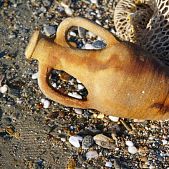
22 ancient shipwrecks discovered near Greek island
Shipwrecks were the stuff of lore around the craggy coasts of Fourni, a Greek archipelago in the eastern Aegean Sea. Generations of local fishermen and sponge divers had seen piles of ancient pottery collecting algae on the seafloor. A group of marine archaeologists finally investigated the waters, and their wealth of findings far exceeded expectations.
During the very first dive of the expedition, the team found the remains of a late Roman-period wreck strewn with sea grass in shallow water. By day 5, the researchers had discovered evidence of nine more sunken ships. The next day, they found another six. By the time the 13-day survey was finished, the divers had located 22 shipwrecks– some more than 2,500 years old — that had never been scientifically documented before.
“I think we were all shocked,” said Peter Campbell, co-director of the project from the U.S.-based RPM Nautical Foundation. “We were expecting three or four wrecks, and we would have been very happy.”
Just how many more wrecks are hidden around Fourni — which lies between the islands of Samos and Icaria — is anyone’s guess, Campbell said. The expedition turned up doomed vessels from the Archaic period (700-480 B.C.) to the late medieval period (16th century A.D.), from depths of 180 feet (55 meters) to as shallow as 10 feet (3 m). And yet, this initial survey covered merely 17 square miles (44 square kilometers), just 5 percent of the archipelago’s coast. Previously, about 180 ancient shipwrecks had been well-documented in all of Greece’s territorial waters. These new discoveries add 12 percent to the total number of known wrecks, the leaders of the project said.
“In a survey, you don’t really choose what you’re going to find — you just dive,” George Koutsouflakis, the Greek director of the survey, from the Ephorate of Underwater Antiquities, told Live Science. “We knew already that Fourni was a hub in navigation in the Aegean, so we had some expectations, but the results surprised us. The importance of this place was underestimated.”
Though Fourni didn’t have major cities, it was notable in the ancient world for its location along Aegean crossing routes, both east-west and north-south. Early Imperial Roman sources say that Fourni was very prosperous, had a robust population and had marble mines in full operation, Koutsouflakis said. But mentions of the archipelago in late Roman texts are scant, which is why the divers were surprised that about half of the wrecks found in the survey date to this period.
“By the late Roman period, we don’t really know anything about the island,” Koutsouflakis said. “Fourni is hardly mentioned in the sources of that time. You see that the shipwrecks tell us a more nuanced story. The island must have maintained importance as a harbor site.”
The main component of these shipwrecks, wood, isn’t likely to survive centuries at the bottom of the sea, unless it is buried in mud without oxygen to fuel decomposition. So far, the wrecks that have been found around Fourni bear few traces of the vessels themselves (though future underwater excavations may change that). Instead, the divers documented messy piles of lost cargo, mostly transport vessels like amphoras, which sank with their ships close to the cliffs on Fourni’s coast.
“A lot of times, you can see near the point of impact where the ships must have crashed, and then you have this scatter pile raining down the underwater slope of the cliff,” Campbell said. “These aren’t the nice ship-shaped piles of amphoras that you sometimes get in ships that wreck far out at sea. We probably do have some of those, but they’re probably farther away from shore.”
Campbell said that of the 22 newly discovered wrecks, three have unique cargos that have never been found before in Mediterranean shipwrecks: a trove of Archaic pots from nearby Samos that was probably destined for Cyprus, but didn’t make it very far; a group of huge second-century A.D. amphoras from the Black Sea region; and a cache of “Sinopian carrots,” or amphoras that come from Sinop on the Black Sea coast of Turkey and, as the name implies, are shaped vaguely like carrots.
Koutsouflakis and Campbell said they intend to go back to Fourni, equipped with underwater robots and other technologies, to search for more wrecks before they plan any underwater excavations. For now, they have taken artifact samples ashore for analysis at a laboratory in Athens, Greece, partly to try to find out what was on board — wine, oil, fish sauce — the ill-fated ships that met their demise at Fourni.















john anderson
-02/04/2017 1:17 pm
As reader (student )of ancient history ,I was amazed & very interested when an article in a sydney newspaper regarding the discovery of the ancient roman ships of the island of fourni ,is there any writings ,books ,articles,on the discoveries ,if so could you please advise me ,titles & where i may locate them ,if notwhen is information going to be available ,would like to know more of the wrecked ships at this site ,would appreciate being updated on the progress at the site ,many thanks & look forward to hearing from you ,,,my very best regards & success on your progress ,john anderson,sydney Australia…